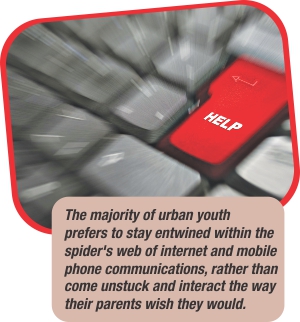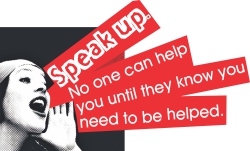Cover Story
Lay Down Your Arms
Cover illustration: Prithi Khalique
Safieh Kabir speaks to Dr Mehtab Khanam about the dangers of feeling alone
Watch the girl, and watch her life. Watch the girl watch her life, as it jumps from axis to orbit to hairpin bend, pirouetting just beyond the scrabbling reach of her fingernails. She looks up at you from between the bare walls of an empty room, and her eyes are starving. “Look at me,” they plead. And then she turns away, and the air of the empty room has distorted into demons, ranked thick and fast and shrieking, their hideous faces too close for even her lips to stir. And where is there to go, if there is nowhere but this room with its biting air?
Watch the girl, who can find nothing to break but her own skin. Watch, as the demons are beaten down by another, blood-red and colossal, and she is safe until it goes, for it can cut no further than her skin. Watch as it leaves, the wounds remain, and the other demons return, with faces more twisted, and cries more cruel than before. And where is she to spiral, if there is nowhere but downwards to go?
 Human beings desperately want to survive. Every electron transfer and broken peptide bond we know of is just a tiny part of each microscopic cell's perpetual struggle for existence. Our bodies contain an entire networks of nerves designed to remove us instantly from danger. Most things in our lives – marriage, employment, laws, society – are just by-products of this all-encompassing desire for self-preservation. So how can it be possible for a creature of this species to overcome every natural instinct, pick up a blade, and slit his own skin?
Human beings desperately want to survive. Every electron transfer and broken peptide bond we know of is just a tiny part of each microscopic cell's perpetual struggle for existence. Our bodies contain an entire networks of nerves designed to remove us instantly from danger. Most things in our lives – marriage, employment, laws, society – are just by-products of this all-encompassing desire for self-preservation. So how can it be possible for a creature of this species to overcome every natural instinct, pick up a blade, and slit his own skin?
We put the question to Dr Mehtab Khanam, a Professor of Psychology at Dhaka University, and a practising counsellor. She explained that self-harm is difficult to rationalise, because it has nothing to do with rational thought. A body can be a punching bag only to the unconscious mind. Logic is abandoned for impulse, and impulse craves release. We asked a few people who used to harm themselves, and the idea of 'distraction' emerged as an evident pattern through all the interviews. When negative thoughts, hurt and hopelessness press too heavy for too long, certain people use the keen edge of physical pain to cut their way to freedom. It creates an adrenaline rush which sweeps them into the bliss of numbness. One of Dr Khanam's patients said that one drop of blood gives greater comfort than a thousand tears. They stop having to “think about the misery”. The actual pain, said another cutter, “hits you like a hangover”, later on. Self-harm may also be, rather than a distraction technique, the outward expression of inner fury at the world, at parents or partners or circumstance. The anger and the helpless feeling of inability is turned back in on oneself and all faltering, flickering self-love is extinguished by self-loathing. “I wanted to tear myself out of my body,” said one interviewee. “I didn't want to see it anymore.”
Dr Khanam often discovered, upon further probing, that her patients had suffered through childhoods ridden with turmoil. Troubled or abusive relationships between parents, or even lack of free communication within the home, can create a pent-up feeling of helplessness within the child. Having had to stand by silently as things go wrong, his attempts to control his environment in the future are more desperate. His pleas for attention are ear-splitting. And self-harm can become his medium for these attempts and pleas. To his short-sighted, depression-dulled eyes, it may seem the method with the highest guarantee of success, for scars will invariably draw notice, and reactions are predictable. This is not to say, of course, that these situations automatically lead to self-harm. That particular result requires the catalyst of personality. Self-harm may be a symptom of Border-line Personality Disorder, a condition that causes people to have long-term emotional turbulence, which leads to impulsive behaviour and induces chaos in their relationships. Those who harm themselves often are, or go on to become, suicidal.
 This writer has observed congealing blood on too many young arms. The frequency with which today's youth resort to self-harm as the solution to their problems is frightening. Dr Khanam has not noticed this increased frequency itself, but she sees self-destructiveness and violence rampant in society, as well as a growing tendency among teenagers to be impulsive rather than calm and patient. These all cause an individual's inclination towards self-harm to increase, and are the result of a number of social changes. The fewer children people have, the greater the time they can afford to spend on each child, to ask them questions and assist them in their decisions. To the average teenager, this kind of attention seems like interference, and feels like a breach of their privacy. They may move further and further away from their parents in their search for personal space. The gap between generations also increases as technology continues on its ceaseless climb, leaving weak legs trailing in its wake. The majority of urban youth prefers to stay entwined within the spider's web of internet and mobile phone communications, rather than come unstuck and interact the way their parents wish they would. Even those less wowed by the hypnotic power of social networking cannot help but be swept along by the revolution in mindsets and outlooks, and if their parents are unwilling to accommodate this change, their thought processes become incompatible.
This writer has observed congealing blood on too many young arms. The frequency with which today's youth resort to self-harm as the solution to their problems is frightening. Dr Khanam has not noticed this increased frequency itself, but she sees self-destructiveness and violence rampant in society, as well as a growing tendency among teenagers to be impulsive rather than calm and patient. These all cause an individual's inclination towards self-harm to increase, and are the result of a number of social changes. The fewer children people have, the greater the time they can afford to spend on each child, to ask them questions and assist them in their decisions. To the average teenager, this kind of attention seems like interference, and feels like a breach of their privacy. They may move further and further away from their parents in their search for personal space. The gap between generations also increases as technology continues on its ceaseless climb, leaving weak legs trailing in its wake. The majority of urban youth prefers to stay entwined within the spider's web of internet and mobile phone communications, rather than come unstuck and interact the way their parents wish they would. Even those less wowed by the hypnotic power of social networking cannot help but be swept along by the revolution in mindsets and outlooks, and if their parents are unwilling to accommodate this change, their thought processes become incompatible.
As communication between the generations becomes less easy, troubled adolescents stop discussing their problems with their parents. The pressure of unexpressed emotions may build up to the extent that some people cut themselves open to ease it off.
The reasons listed so far all rationalise this gruesome decision to mutilate yourselves, so why should you stop? Because it doesn't solve anything. All the pain provides is a stop-gap, a temporary fix to problems that need immediate attention, problems that twist and transform themselves into chimeras of deep-rooted resentment with every passing moment. And in the process of this postponement, you subject your own body to the treatment no human being deserves.
There is always another way. Those we talked to realise, looking back on their experiences, that they resorted to self-harm because they didn't know how to cope. One interviewee suggested that a better grip of one's emotions, and clearer ideas of what's important, may help to overcome the impulse to harm oneself. Another wanted to send out the message that no matter how you feel, you are never alone. Dr Khanam's urgent instructions to friends of self-harmers is to send them to a psychotherapist. The ideas that lead to self-harm are rooted deep in an individual's psyche, and the uprooting is too difficult and complex a task for a friend to handle. Support them as they go through therapy, but make sure your friend receives professional help.
The troubled wrap themselves in silence because they're afraid no one will want to listen, or be able to understand. But there is always someone willing to listen, to try their best to understand. Speak up. No one can help you until they know you need to be helped. And nothing they say or do can be worse than drowning your hurt in your own blood.
BETA WRITER
We got very few entries this week but the one below was by far, the best of the lot. Topics can only limit you so much if you know how to play with words. For next week our topic is 'Arrr!' Have fun with it, mateys. All submissions need to be sent in to ds.risingstars@gmail.com by Sunday noon. Word limit: 350-500 words. May the luck be wit' ye, scurvy mongrels.
Voodo
By Annie Akhtar
Bat fangs.
Komodo dragon tongue.
White tiger claws.
Deer hooves.
Elephant blood.
It took her long to acquire it all, but now that it was done. She carefully placed all of it into a tiny wooden box. She put the bar of wax into it and wrapped it with the last ingredient she had acquired. His hair.
She put the box over the fire and repeated the enchantments instilled into her mind. So familiar with it that the words flowed like water from her lips. She looked at the box; she swore she saw a spark. Half smiling, she picked the box out of the fire and looked into it; the wax had melted and mixed itself with the other ingredients.
She used her hands to give the wax the shape she wanted, his shape. Her smile grew bigger. Tomorrow was the day. The final day. How long had she waited for this?
She tied the lock of his hair around the wax doll and put it back into the box. The rest was for tomorrow. She would wait. She would try to sleep. She would try.
He was beautiful. His black hair would fall over his eyes; which were a shade of hazel and they shined bright. Or was it just the reflection of the fire burning in them? He stood there, completely still and she knew what to do. She hid behind the bushes, her wax doll in her hand. She recited the verse, familiar verse, it shouldn't be difficult. But it was. Her hands were sweaty and shaking, but she took a deep breath and closed her eyes. Yes, much better. All dark. She didn't need to see what she was doing. She just had to do it.
The words came out, effortlessly now. She took the doll's left hand and twisted it around. She couldn't see, but she heard the bloodcurdling scream. She wouldn't see, she wouldn't hear. She kept going. Right hand now. The scream was louder, she heard him begging. “Please,” he repeated over and over, again.
She twisted the doll's legs now. The screams were even louder, impossible to drown out. “Make it quick, do it now,” he screamed. He wasn't begging for life. She had gotten it wrong. Or maybe he was wrong. She twisted the doll's head.
It was over.
The old Konkhon tribe leader marveled at her work. He put the garland of wildflowers over her head and the rest of the tribe cheered and rejoiced. She stood there by her father, the tribe's leader, watching the celebration. The princess had finally mastered voodoo magic. The age old ritual of her tribe, used to punish anyone who dared to trespass into their land. Where love and death amalgamate into wondrous magic.
